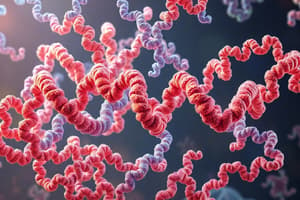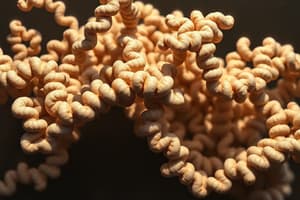Podcast
Questions and Answers
What is the configuration of most peptide bonds not involving proline?
What is the configuration of most peptide bonds not involving proline?
- Cis
- Trans (correct)
- Random
- None of the above
Which amino acids are commonly found in b turns?
Which amino acids are commonly found in b turns?
- Glycine and Leucine
- Proline and Glycine (correct)
- Alanine and Serine
- Cysteine and Aspartic acid
What is the typical number of residues per turn in an alpha helix?
What is the typical number of residues per turn in an alpha helix?
- 3.6 residues (correct)
- 5.0 residues
- 2.5 residues
- 4.5 residues
What stabilizes the turn in b turns?
What stabilizes the turn in b turns?
What type of amino acids are known to be strong helix formers?
What type of amino acids are known to be strong helix formers?
How does proline influence the structure of an alpha helix?
How does proline influence the structure of an alpha helix?
Which of the following best describes the tertiary structure of a protein?
Which of the following best describes the tertiary structure of a protein?
What type of structure does collagen exhibit?
What type of structure does collagen exhibit?
In the context of an alpha helix, which direction do side chains typically point?
In the context of an alpha helix, which direction do side chains typically point?
What structural characteristic of beta sheets is determined by the orientation of strands?
What structural characteristic of beta sheets is determined by the orientation of strands?
What is a characteristic of fibrous proteins?
What is a characteristic of fibrous proteins?
Which peptide bond orientation leads to a strong dipole moment in an alpha helix?
Which peptide bond orientation leads to a strong dipole moment in an alpha helix?
What class of protein includes collagen?
What class of protein includes collagen?
How many amino acids are typically involved in a 180° turn in b turns?
How many amino acids are typically involved in a 180° turn in b turns?
What is the typical inner diameter of an alpha helix without side chains?
What is the typical inner diameter of an alpha helix without side chains?
What interaction primarily stabilizes the structure of beta sheets?
What interaction primarily stabilizes the structure of beta sheets?
What type of interaction largely stabilizes protein tertiary structure?
What type of interaction largely stabilizes protein tertiary structure?
Which property distinguishes silk fibroin from α-Keratin?
Which property distinguishes silk fibroin from α-Keratin?
Which of the following residues is often found near the positive end of the alpha helix dipole?
Which of the following residues is often found near the positive end of the alpha helix dipole?
What is the term used to describe the specific three-dimensional conformation of proteins that fulfills a biological function?
What is the term used to describe the specific three-dimensional conformation of proteins that fulfills a biological function?
Which type of interaction is primarily responsible for stabilizing the secondary structure of proteins such as alpha helices and beta sheets?
Which type of interaction is primarily responsible for stabilizing the secondary structure of proteins such as alpha helices and beta sheets?
What is the main reason for the rigidity and planarity of the peptide bond?
What is the main reason for the rigidity and planarity of the peptide bond?
Which of the following statements accurately describes the hydrophobic effect in protein folding?
Which of the following statements accurately describes the hydrophobic effect in protein folding?
What defines the primary structure of a protein?
What defines the primary structure of a protein?
Which of the following interactions contributes most significantly to the stability of the interior of proteins?
Which of the following interactions contributes most significantly to the stability of the interior of proteins?
What term is given to irregular arrangements of the polypeptide chain that do not form a defined structure?
What term is given to irregular arrangements of the polypeptide chain that do not form a defined structure?
What kind of interactions do salt bridges involve in protein structure?
What kind of interactions do salt bridges involve in protein structure?
Which of the following structures is stabilized by hydrogen bonds between nearby residues in the polypeptide chain?
Which of the following structures is stabilized by hydrogen bonds between nearby residues in the polypeptide chain?
What is required for the posttranslational processing of proline to hydroxyproline?
What is required for the posttranslational processing of proline to hydroxyproline?
What does the presence of a large dipole moment in the peptide bond favor?
What does the presence of a large dipole moment in the peptide bond favor?
What type of bond forms the cross-links between collagen triple-helices?
What type of bond forms the cross-links between collagen triple-helices?
Which of the following statements about protein motifs is true?
Which of the following statements about protein motifs is true?
What occurs when a protein loses its structural integrity?
What occurs when a protein loses its structural integrity?
Which describes the characteristics of a quaternary structure in proteins?
Which describes the characteristics of a quaternary structure in proteins?
Given that correctly folded β-amyloid is a soluble globular protein, what happens when it is misfolded?
Given that correctly folded β-amyloid is a soluble globular protein, what happens when it is misfolded?
Which of the following agents can denature proteins?
Which of the following agents can denature proteins?
How does the folded structure of a protein impact its functionality?
How does the folded structure of a protein impact its functionality?
Which type of secondary structure is NOT considered a fundamental element in proteins?
Which type of secondary structure is NOT considered a fundamental element in proteins?
What general process describes how proteins achieve their 3D structures?
What general process describes how proteins achieve their 3D structures?
Flashcards
Native Fold
Native Fold
The three-dimensional structure of a protein that allows it to perform a specific biological function.
Hydrophobic Effect
Hydrophobic Effect
The release of water molecules from around a protein as it folds, making the process more favorable due to increased entropy.
Hydrogen Bonds in Proteins
Hydrogen Bonds in Proteins
Interactions between N-H and C=O groups in the peptide bond, leading to structures like alpha helices and beta sheets.
London Dispersion Forces
London Dispersion Forces
Signup and view all the flashcards
Electrostatic Interactions
Electrostatic Interactions
Signup and view all the flashcards
Primary Structure
Primary Structure
Signup and view all the flashcards
Peptide Bond
Peptide Bond
Signup and view all the flashcards
Secondary Structures
Secondary Structures
Signup and view all the flashcards
Alpha Helix
Alpha Helix
Signup and view all the flashcards
Beta Sheet
Beta Sheet
Signup and view all the flashcards
Alpha Helix Structure
Alpha Helix Structure
Signup and view all the flashcards
Alpha Helix Pitch
Alpha Helix Pitch
Signup and view all the flashcards
Alpha Helix with a Hydrophobic Face
Alpha Helix with a Hydrophobic Face
Signup and view all the flashcards
Proline as a Helix Breaker
Proline as a Helix Breaker
Signup and view all the flashcards
Glycine as a Helix Breaker
Glycine as a Helix Breaker
Signup and view all the flashcards
Helix Dipole
Helix Dipole
Signup and view all the flashcards
Parallel Beta Sheet
Parallel Beta Sheet
Signup and view all the flashcards
Antiparallel Beta Sheet
Antiparallel Beta Sheet
Signup and view all the flashcards
Antiparallel β-sheets
Antiparallel β-sheets
Signup and view all the flashcards
β-turn
β-turn
Signup and view all the flashcards
Glycine in β-turns
Glycine in β-turns
Signup and view all the flashcards
Proline in β-turns
Proline in β-turns
Signup and view all the flashcards
Trans configuration
Trans configuration
Signup and view all the flashcards
Cis configuration
Cis configuration
Signup and view all the flashcards
Tertiary structure
Tertiary structure
Signup and view all the flashcards
Fibrous protein
Fibrous protein
Signup and view all the flashcards
Globular protein
Globular protein
Signup and view all the flashcards
α-Keratin
α-Keratin
Signup and view all the flashcards
4-Hydroxyproline in Collagen
4-Hydroxyproline in Collagen
Signup and view all the flashcards
Collagen Fibril Formation
Collagen Fibril Formation
Signup and view all the flashcards
Protein Motifs (Folds)
Protein Motifs (Folds)
Signup and view all the flashcards
Quaternary Structure
Quaternary Structure
Signup and view all the flashcards
Protein Denaturation
Protein Denaturation
Signup and view all the flashcards
Protein Folding
Protein Folding
Signup and view all the flashcards
Protein Misfolding
Protein Misfolding
Signup and view all the flashcards
Determining Protein Structure
Determining Protein Structure
Signup and view all the flashcards
Study Notes
Protein Structure
- Protein molecules adopt a specific three-dimensional conformation.
- This conformation allows the protein to fulfill a specific biological function.
- The specific three-dimensional structure is called the native fold.
- The native fold has numerous favorable interactions within the protein.
- There is an energy cost associated with folding a protein into one specific native fold.
- Favorable interactions in proteins include the hydrophobic effect, hydrogen bonds, London dispersion forces, and electrostatic interactions.
- The hydrophobic effect is the release of water molecules from structured solvation layers as the protein folds, increasing net entropy.
- Hydrogen bonds form from N-H and C=O interactions of the peptide bond creating regular structures like a helices and β sheets.
- London dispersion forces are medium-range weak attractions between atoms within the protein.
- Electrostatic interactions involve permanent charged groups in the protein, producing salt bridges (particularly important within hydrophobic environments).
Four Levels of Protein Structure
- Primary structure: The linear sequence of amino acid residues.
- Example given: MTYKLILNGKTLKGETTTEAVDAATAEKVFKQYANDNGVDGEWTYDDATKTF TVTE.
- Secondary structure: Local spatial arrangement of the polypeptide backbone. Two common types are:
- α-helix: Stabilized by hydrogen bonds between nearby amino acid residues (n and n+4). It's a right-handed helix with 3.6 residues per turn (5.4 Å per turn). Side chains point outward.
- β-sheet: Stabilized by hydrogen bonds between adjacent segments (may not be near to each other). Side chains alternate up and down. Can be parallel or antiparallel.
- β-turns: Frequent turns in β sheets. Stabilized by a hydrogen bond between the C=O of one amino acid and the N-H of another three residues down the polypeptide chain. Proline or glycine are often found in β-turns.
- Tertiary structure: Overall spatial arrangement of all atoms in a protein. Stabilized by numerous weak interactions between amino acid side chains (hydrophobic and polar interactions, disulfide bonds). Interacting amino acids are not necessarily adjacent in the primary structure. Two major classes of proteins are: fibrous and globular.
- Quaternary structure: Formed by the assembly of multiple polypeptides into a larger functional cluster.
Fibrous Proteins
- Tough, insoluble protective structures (e.g., a-keratin).
- Soft, flexible filaments (e.g., silk fibroin).
- High tensile strength (e.g., collagen).
- Examples include a-keratin in hair, feathers, and nails; silk fibroin in silk; collagen in tendons, cartilage, and bones.
Globular Proteins
- Water soluble proteins
- Composed of different motifs folded together
- Examples include: a-helices, β sheets, β-α-β loops, β barrels.
Protein Stability and Folding
- Protein function relies on its three-dimensional structure.
- Denaturation occurs when the protein loses its structural integrity and activity.
- Denaturing agents include heat, cold, pH extremes, organic solvents, and chaotropic agents (urea, guanidinium hydrochloride).
- Proteins fold according to a specific path. This path often involves the formation of local secondary structures (like a-helices and β-sheets), followed by the folding of these structures into the overall tertiary structure of the protein.
- Protein misfolding can lead to various human diseases.
Key Terminology
- Peptide bond: A covalent bond between the carboxyl group of one amino acid and the amino group of another.
- Dipole moment: A property of having positive and negative charges separated within a molecule
Studying That Suits You
Use AI to generate personalized quizzes and flashcards to suit your learning preferences.




